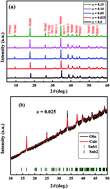Electrical, magnetic and magnetotransport properties of Na and Mo doped Ca3Co4O9 materials
Abstract
We report the electrical, magnetic and magnetotransport properties of Na and Mo dual doped Ca3−2xNa2xCo4−xMoxO9 (0 ≤ x ≤ 0.15) polycrystalline samples. The results indicate that the strength of ferrimagnetic interaction decreases with increase in doping, as is evident from the observed decrease in Curie temperatures (TC). The substitution of non-magnetic Mo6+ ions (4d0) in CoO2 layers and the presence of oxygen vacancies are responsible for decrease in ligand field strength, which results in an enhanced magnetization in the low doped x = 0.025 sample due to a change from the low spin to partial high spin electron configuration. The electrical resistivity of samples exhibits a semiconducting-like behavior in the low temperature range, a strongly correlated Fermi liquid-like behavior in the intermediate temperature range, and an incoherent metal-like behavior in the temperature range 210–300 K. All the samples show a large negative magnetoresistance (MR) at low temperature with a maximum MR value of −59% for the x = 0.025 sample at 2 K and 16 T applied field. The MR values follow the observed trend in magnetization at 5 K and sharply increase below the Curie temperatures of the samples, suggesting that the ferrimagnetic interactions are mainly responsible for the decrease in electrical resistivity under an applied magnetic field.



 Please wait while we load your content...
Please wait while we load your content...